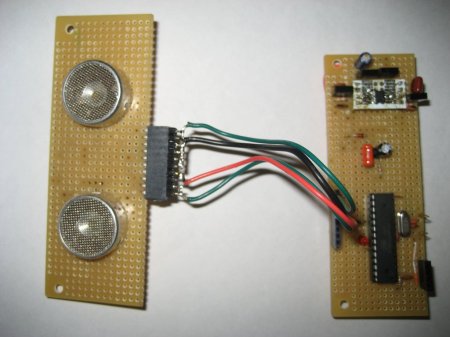
After finding some ultrasonic transducers online for a dollar each [Kerry Wong] decided to create an ultrasonic range finder. The result is much like parallax’s PING))) sensor but much cheaper. His post is not only a good way to save some money, but also does a good job of explaining how ultrasonic sensors work. The transmit circuit is essentially an H-bridge, much like what you would use to control a motor. To listen to the returning echo he uses a pair of high gain/low noise op-amps to filter and amplify the signal. The board he uses to test the range finder (not included in the cost) is an ATMega328 running the Arduino boot loader. He also provides lots of example code to boot.
















source link seems dead, did we do that?
Domain seems to be down right now…
google cache, text only
http://webcache.googleusercontent.com/search?q=cache:O9FqgQYiJNUJ:www.kerrywong.com/2011/01/22/a-sensitive-diy-ultrasonic-range-sensor/+www.kerrywong.com+sensitive-diy-ultrasonic-range-sensor&hl=en&gl=us&strip=1
Sweet, hopefully it’ll help me once the page recovers from the DDoS :P I tried creating something similar a while back but gave up. Circuits like these seem more like voodoo than science *sigh*
@ sneakypoo
Agreed.
Sigh… self hosting, through a DSL line no less. When will people learn? You can get a super cheap shared host for next to nothing now.
Anyone know how to make a laser range finder. Small and light weight?
@golddigger
camera and a laser pointer on a stick. If you know the length of the stick and the angle of the laser pointer compared to the camera, it is just trig.
Smaller it is, the less accurate or more expensive it gets.
Thanks for your reply! I have been through the google searches and I have seen the people doing work with webcams. But I was hoping for something less conpicious. The trig method with a cell phone camera and an eye safe laser pointer would be ideal, but I wouldn’t know where to begin. If anyone could point me in the right direction, it would be appreciated.
I like seeing an embedded arduino like this. I’ve built arduinos before and they work great. $6 can easily replace a $40 basicstamp or $30 arduino board.
very nice build
I’m building a Geocache GPS that I’ll be able to load coordinates into and track them down. Its like a reverse reverse geocache lol. It will have a standalone arduino like this.
I love the Parallax Ping but hate its price so thank you for the great project!
Site is back up as of right now for anyone interested.
@adam
I hate trying to incorporate a whole arduino board into a project. Its a waste of money and connectors. The only 2 cases I can think of would be a very temporary project (arduino controlled xmas lights) or a dedicated shield to bootload other AVRs.
So where did he find the sensors? I can’t find them. If they’re a dollar each, then I definitely want some.
golddigger, zing-
A lot of cheap laser pointers can project designs like a smiley face or a star instead of just a dot. Measure the distance between star points or the eyes on the face.
@Mason: I believe the site he got them from is; http://www.allelectronics.com/make-a-store/item/XDR-24/ULTRASONIC-TRANSDUCER//1.html
Rusty
@Rusty
Thank you very much
my version:
http://elcoyotequesuelda.blogspot.com/2010/12/mas-sensores-ultrasonicos.html
the range is 2cm-2mt and the accuracy is 3mm.
now i have 6 and i am building another 5.
i’m not using an H bridge, just a transistor and an inductor in parallel with the transducer (that gives you like 50v in the transducer)
then i amplify the rx in 2 stages a couple thousand times with 2 high pass filters
How similar is this technique to the ultrasound used in baby scans? Could this be used as a Diy scanner or would there be risks? 3mm precision sounds very promising and a fascinating project, good work.
This an an appropriate app would be awesome to put onto a Spy Gear Video Trakr, if they would release the GPIO pins already.
Sorry to veer off topic.
@Lucassiglo21
Those look very nice. Have you considered selling them?
yeah, i have considered that, and i think i’m going to. i would sell a version with smaller transducers, 10mm in diameter. and i would love to use an smd microcontroller, but i couldn’t find them here.
i’ve made these because the parallax ones are too hard to get, and they cost like 65 dollars each.
I recently had to purchase 5 high frequency ultrasonic capsules for a project. I found a site that sells them for $0.75 each (40 kHz), but with a minimum order quantity of 10. http://www.satistronics.com/basic-ultrasonic-sensor-16mm-diameter-rx-tx-one-pair_p2207.html
@Lucassiglo21
I was hoping the source was going to be made available, I’d like to try building one or 3.
i am using a pic12f675, it sends the 40khz burst, and waits for the response from the RX amplifier, the ADC was too slow, so i am using an internal comparator and an internal voltage reference module to get the response.
i didn’t publish the code mainly because it is used for a sumo robot competition, and i want to use them there. and i would be the first one with homemade ultrasonic sensors there. if i release the code and the schematics i lose my advantage in the competition.
i am also selling them.
anyway, it’s not that hard to do it. and you have to calibrate the detection voltages versus time for the comparator, and that varies with the construction and sensor sensitivity, so even if i publish the code, it will be probably useless.
http://elcoyotequesuelda.blogspot.com/2011/01/sensor-ultrasonico-variante-2.html